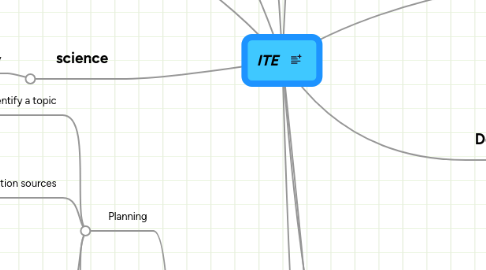
1. Assessment
1.1. Peer
1.1.1. Informal
1.1.2. Comments on blog, wiki etc.
1.2. Self
1.2.1. Weekly form: 'I learned this week...'
1.2.2. Reflective journaling: Weekly entries on form
1.3. Supervisor
1.3.1. signs off time sheets
1.3.2. may evaluate student occasionally: 'Student adheres to school rules etc.
1.4. Teacher
1.4.1. Project based assessment
1.4.2. Time management, professionalism, commitment to class, readiness to engage in learning and take initiative etc.
1.4.3. Compiles timesheets
1.4.4. generates rubrics for assessment
2. Student
2.1. responsibilities
2.2. expectations
2.3. opportunities
2.4. grouping
3. Stake Holders
3.1. Students
3.2. Instructor
3.3. Principals
3.4. Teachers
3.5. Technicians
4. Process
4.1. Planning
4.1.1. Identify a topic
4.1.1.1. built, distribute and maintain computers to students at your school
4.1.2. Identify information sources
4.1.2.1. ITE course members and teacher
4.1.2.2. ITE website
4.1.2.3. community professionals
4.1.2.4. online groups and sources
4.1.3. Establish evaluation criteria
4.1.3.1. collect feed back from students who use computers
4.1.3.2. collect feedback from teachers
4.1.4. Outline a plan for action
4.1.4.1. in collaboration with your school principal, technology teacher, supervisor teacher, school technician and Mr. Meyer, discuss how to best achieve your goals
4.2. Retrieving
4.2.1. Locate and collect resources
4.2.1.1. what is required? What is needed?
4.2.1.2. communicate needs to teacher
4.2.2. Develop information retrieval plan
4.2.3. Select useful information
4.2.4. Evaluate information
4.2.5. Review and Revise plan for inquiry
4.3. Processing
4.3.1. Create a focus
4.3.1.1. provide laptop computers to students at your school
4.3.1.2. be the student IT team at your school
4.3.1.3. help out students and teachers with their computers
4.3.1.4. be an active participant in the ITE course
4.3.2. Record information
4.3.2.1. ongoing collection of information of who uses computers, who maintains them, trouble shooting, making them available to students etc.
4.3.2.2. information should be recorded in a format that makes it easy to share with teacher and peers.
4.3.2.2.1. Podcasts; teacher and student generated
4.3.2.2.2. Blog posts (text, photo etc.) to describe experiences, generate discussion or solve problems.
4.3.2.3. If possible, teacher should always be able to access latest information 24/7
4.3.3. make connections
4.3.3.1. identify others with an interest in computers
4.3.3.2. who in your community would benefit from someone with skills in IT?
4.3.3.3. look for training opportunities after high school
4.3.3.4. establish a help group for other students at your school
4.3.4. review and revise plan
4.3.4.1. ongoing discussion during video and online meetings with ITE class
4.4. Creating
4.4.1. organize information
4.4.2. create product
4.4.3. think about audience
4.4.4. reise and review plan for inquiry
4.5. Sharing
4.5.1. communicate with audience
4.5.2. present new understandings
4.5.3. demonstrate appropriate behavior
4.6. Evaluating
4.6.1. evaluate product
4.6.2. transfer learning to new situations
4.6.3. evaluate process
5. science
5.1. chemisyrty
6. Delivery Modes
6.1. In person
6.1.1. Rotating
6.1.2. frequency changes
6.1.3. labs
6.1.4. Camp at school
6.2. Video Conference
6.2.1. Scheduled
6.2.2. Frequency changes
6.3. Phone conference
6.3.1. scheduled
6.3.2. as needed
6.4. Schedule
6.4.1. day 2
6.4.1.1. Vc; discussion: questions from elluminate session
6.4.2. day 1
6.4.2.1. Elluminate; primarily for delivery of content, chapter based
6.4.3. day 3
6.4.3.1. VC; discussion
6.4.4. day 4
6.4.4.1. Elluminate; primarily for delivery of content, chapter based
6.4.5. day 5
6.4.5.1. Vc, school visit, demos, discussion, experiences at your school, guests etc.
7. Equipment
7.1. Existing
7.2. New
7.2.1. Videoconference
8. Community
8.1. opportunities
8.1.1. help out at care centres
8.1.2. organize a LAN party
8.1.3. ask local elementary schools if help is needed
8.1.4. New node
8.2. New node
9. Modules
9.1. 3 credits:Choice
9.1.1. INF2010
9.1.2. ELT2070
9.1.3. ELT2330
9.1.4. CTR3040
9.1.5. CTR3050
9.1.6. ELT2360
9.2. 5 credits
9.2.1. INF2010
9.2.2. ELT2070
9.2.3. ELT2330
9.2.4. CTR3040
9.2.5. CTR3050
9.2.6. ELT2360
10. Mechanics of Delivery
10.1. Sites
10.1.1. Receiving
10.1.2. Sending
